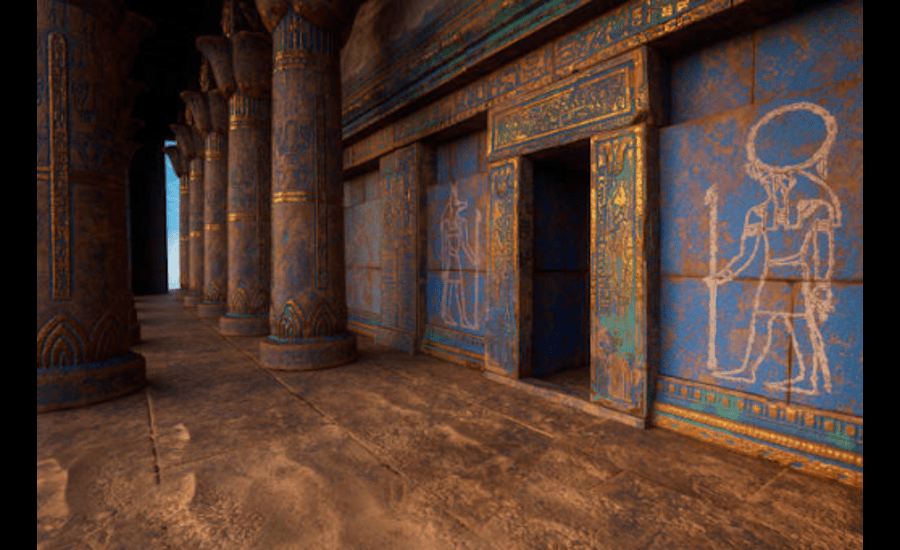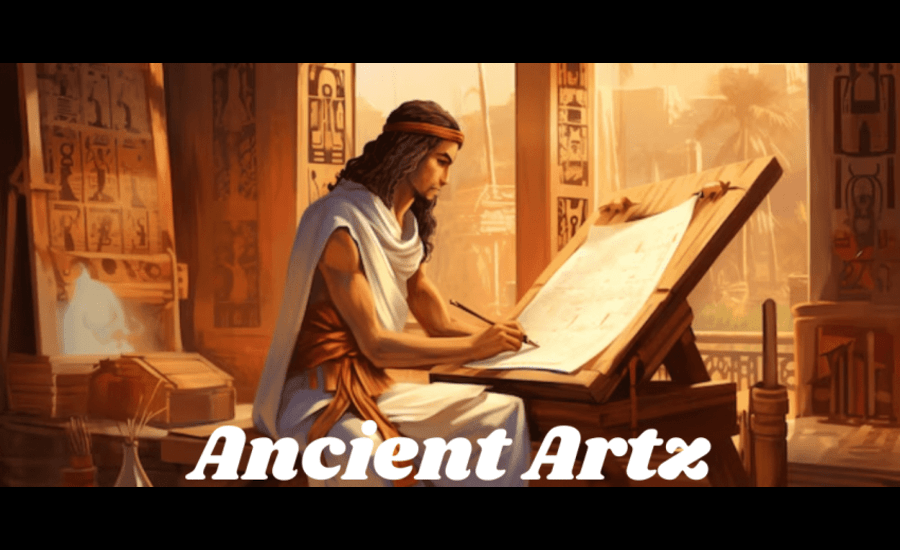Ancient Artz: A Journey Through the Artistic Expressions of Antiquity
The ancient artz world was an age of wonder, innovation, and creativity. Art from this time reflects the very essence of early human civilizations, capturing their beliefs, ideals, and the essence of their daily lives. From the sands of Egypt to the rolling hills of Greece, ancient art serves as a powerful reminder of the ingenuity of our ancestors and the cultural legacies they left behind. The artistic expressions of antiquity are much more than relics; they are vivid, enduring statements of identity, politics, religion, and philosophy. In this article, we will embark on a journey through the artistic expressions of ancient civilizations, exploring the different mediums, techniques, and cultural significance that have shaped the world as we know it.
The Origins of Ancient Art: The Prehistoric Era
Art in the prehistoric era was raw, unrefined, and yet remarkably profound. The earliest known examples of prehistoric art date back to the Upper Paleolithic period, roughly 40,000 years ago. Furthermore, this art, often painted on the walls of caves, served as a means of communication, expression, and possibly even ritualistic purpose. The most famous examples include the cave paintings of Lascaux in France and Altamira in Spain.
These early works of art depict animals such as horses, bison, and deer, rendered in vivid colors and dynamic movement. Scholars believe these images may have been part of religious ceremonies or used to teach hunting techniques to younger members of the tribe. Prehistoric art was not limited to cave paintings, however. Small sculptures, like the “Venus of Willendorf,” show early humans’ interest in fertility and the human form, marking some of the earliest attempts to depict the human body artistically.
Although rudimentary in nature, prehistoric art laid the foundation for more complex forms of artistic expression that would emerge in later civilizations. The tools used, the pigments created from natural resources, and the symbolic meanings behind the images all speak to the deep-rooted connection between early humans and their environment.
The Venus Figurines: Symbols of Fertility or Spirituality?
One of the most intriguing aspects of prehistoric art is the recurring motif of the “Venus figurines.” These small, carved statues of women, often with exaggerated physical features, have been found in locations spanning Europe and Asia. Their widespread presence suggests they had significant cultural or spiritual importance.
Scholars have debated the purpose of these figurines for decades. Some believe they represent fertility deities, as the emphasis on the breasts, hips, and thighs may have symbolized childbirth and femininity. Others argue that the figurines may have had a more ritualistic purpose, perhaps representing a mother goddess worshipped by early peoples. Whatever their purpose, the Venus figurines reflect early humans’ fascination with the female form and their desire to understand the mysteries of life and reproduction.
The Use of Tools and Materials in Prehistoric Art
The creation of prehistoric art involved the use of rudimentary tools and materials, many of which were sourced directly from the natural environment. Pigments were made from minerals such as ochre, charcoal, and manganese dioxide, while tools like bones and stones were used to carve or etch designs. The art of the prehistoric era was, therefore, deeply connected to the earth, reflecting the survival instincts and resourcefulness of early humans.
Cave paintings, for example, were created using various techniques, including finger painting, blowing pigments through hollowed-out bones, and using primitive brushes made from plant fibers or animal hair. This resourcefulness in artistic techniques illustrates the innate human desire to create, even with limited means, and highlights the importance of artistic expression in prehistoric communities.

Egyptian Art: A Harmonious Blend of Religion and Politics
Furthermore, few civilizations are as synonymous with ancient artz as Egypt. Egyptian art, spanning over 3,000 years, is a stunning testament to the creativity and craftsmanship of this early civilization. Unlike the fluid, dynamic nature of prehistoric art, Egyptian art is known for its strict adherence to form, proportion, and symmetry. This stylistic choice was not merely an aesthetic preference but a reflection of the civilization’s deep spiritual and religious beliefs.
Egyptian art was intrinsically tied to the concepts of order and harmony, which were central to their religion. The gods, pharaohs, and the afterlife were depicted in a consistent, idealized form, ensuring that these divine beings were portrayed in a manner befitting their eternal status. The figures in Egyptian paintings and sculptures are often presented in a frontal pose with rigid, geometric shapes that convey a sense of permanence and stability.
One of the most iconic examples of Egyptian art is the Great Sphinx of Giza. Carved from limestone, the Sphinx represents the pharaoh Khafre and is a prime example of how Egyptian art was used to immortalize the ruling class and align them with the gods. The imposing size of the Sphinx, combined with its serene expression, embodies the divine power that the pharaohs were believed to possess.
Symbolism in Egyptian Art
Egyptian art was highly symbolic, with each element carefully chosen to convey meaning. Colors, poses, and even the size of the figures were all laden with significance. For example, the color green represented fertility and rebirth, while blue symbolized the Nile and the sky, often associated with divinity. The use of size in Egyptian art was also hierarchical, with gods and pharaohs depicted as larger than other figures to emphasize their superior status.
Hieroglyphs, the ancient Egyptian writing system, were often integrated into works of art, further blending the visual and the textual in their symbolic communication. Hieroglyphs not only served as a means of writing but also held artistic merit, with their intricate designs often accompanying larger scenes in tombs and temples.
The Role of Art in the Afterlife
One of the most fascinating aspects of Egyptian art is its role in the afterlife. Much of the art produced by the Egyptians was created for tombs and temples, designed to assist the deceased in their journey to the afterlife. The walls of these tombs were adorned with detailed depictions of the dead making offerings to the gods, hunting, or engaging in other activities that would ensure their safe passage to the afterlife.
The most famous example of this is the tomb of Tutankhamun. Discovered in 1922 by archaeologist Howard Carter, the tomb contained a wealth of artistic treasures, including the now-iconic golden death mask of the young pharaoh. Every item in the tomb was carefully crafted to serve a specific purpose in the afterlife, reflecting the Egyptians’ belief that art could transcend the physical world and aid the soul in its eternal journey.
The Artistic Legacy of Ancient Greece: A Study in Idealism and Realism
Moving from Egypt to Greece, we find a civilization that transformed art through its pursuit of balance between idealism and realism. Ancient Greek art is celebrated for its exploration of the human form, which was depicted with unprecedented accuracy and beauty. Greek artists sought to capture not only the physical likeness of their subjects but also their idealized perfection, resulting in some of the most renowned sculptures and architecture in history.
Greek art evolved through several distinct periods: the Geometric, Archaic, Classical, and Hellenistic. Each period introduced new techniques and ideas that gradually moved Greek art towards a more naturalistic style. The early Geometric period was characterized by abstract forms and shapes, but by the Classical period, Greek artists had developed an extraordinary skill in depicting the human body in motion, often with a focus on proportion, anatomy, and balance.
The Parthenon: An Architectural Masterpiece
The Parthenon, a temple dedicated to the goddess Athena, stands as one of the most significant examples of Classical Greek art. Built between 447 and 432 BCE, the Parthenon exemplifies the Greek ideals of symmetry, proportion, and harmony. Its columns and friezes are adorned with intricate carvings that celebrate the gods and the city of Athens, while the overall structure reflects the Greeks’ advanced understanding of mathematics and engineering.
The Parthenon’s design represents the pinnacle of the Doric order of architecture, characterized by simple, sturdy columns and a lack of elaborate ornamentation. However, the real beauty of the Parthenon lies in its sculptural decoration, particularly the frieze that runs along its inner walls. This frieze depicts the Panathenaic procession, a religious festival in honor of Athena, and showcases the Greeks’ ability to convey movement and emotion through stone.
Greek Sculpture: The Perfection of the Human Form
Greek sculpture reached its zenith during the Classical period, with artists like Phidias, Polykleitos, and Myron achieving new heights in the portrayal of the human form. Sculptures from this time are renowned for their realism and idealism, combining accurate anatomy with an idealized sense of beauty.
The “Discobolus” (Discus Thrower) by Myron, for example, captures the athlete in mid-motion, showcasing the dynamism and energy of the human body. Meanwhile, Polykleitos’ “Doryphoros” (Spear Bearer) exemplifies his treatise on the ideal proportions of the human figure, known as the “Canon.” This focus on proportion and balance would influence Western art for centuries to come.
Greek sculptures were not just about aesthetic beauty; they also conveyed philosophical ideas about the nature of humanity and the gods. The Greeks believed that the human body was a reflection of divine perfection, and their art sought to capture this harmony between the physical and the spiritual.
Roman Art: A Testament to Power and Propaganda
While the Romans borrowed heavily from Greek art, they also made significant contributions of their own, particularly in the realms of architecture, portraiture, and propaganda. Roman art was deeply intertwined with the politics of the empire, often used to convey the power and authority of the emperor and the state.
Roman portraiture, for example, was highly realistic, often emphasizing the individual characteristics of the subject rather than idealizing them. This focus on realism can be seen in the busts of Roman emperors, which were used to convey their authority and status. Unlike the idealized forms of Greek sculpture, Roman portraiture captured the imperfections and individuality of its subjects, reflecting the Romans’ interest in the individual and the state.
The Use of Art as Propaganda
One of the most significant contributions of Roman art was its use as propaganda. The Roman Empire was vast, and its rulers needed a way to communicate their power and legitimacy across diverse populations. Furthermore, art, particularly monumental architecture and public works, became a key tool in this effort.
Triumphal arches, such as the Arch of Titus, were erected to commemorate military victories and celebrate the emperor’s achievements. These arches were often decorated with detailed reliefs depicting scenes of conquest and divine favor, reinforcing the idea that the emperor was chosen by the gods to rule.
The Ara Pacis, or Altar of Peace, is another example of Roman art used for political purposes. Commissioned by Emperor Augustus, the altar celebrates the peace and prosperity brought about by his reign. The reliefs on the altar depict both mythological and historical scenes, linking Augustus’ rule with the divine and reinforcing his position as the legitimate ruler of Rome.
Roman Mosaics: A Fusion of Art and Everyday Life
Roman mosaics, often found in the homes of the wealthy, provide a glimpse into the everyday life of the empire. These intricate artworks, made from small pieces of colored stone or glass, depict a wide range of subjects, from mythological scenes to depictions of animals, plants, and people.
Mosaics were not only decorative but also served as status symbols, showcasing the wealth and sophistication of the homeowner. The detail and craftsmanship of Roman mosaics are remarkable, with some works depicting elaborate scenes that rival the finest paintings.
One of the most famous examples of Roman mosaic art is the “Alexander Mosaic,” found in the House of the Faun in Pompeii. This mosaic depicts the Battle of Issus between Alexander the Great and the Persian king Darius III. The mosaic’s composition and attention to detail demonstrate the Romans’ ability to convey complex narratives through this medium, blending artistic skill with historical storytelling.
Ancient Artz in Mesopotamia: Power, Divinity, and Innovation
Mesopotamia, often referred to as the “cradle of civilization,” was home to some of the earliest known forms of writing, architecture, and art. Located between the Tigris and Euphrates rivers, this region was the birthplace of the Sumerians, Akkadians, Babylonians, and Assyrians, each of whom made significant contributions to the development of art in the ancient world.
Mesopotamian art is characterized by its focus on power, divinity, and innovation. Much like Egyptian art, Mesopotamian art was deeply tied to religion and the ruling class, with kings often depicted as divine or semi-divine figures. Ziggurats, monumental structures that served as temples, are some of the most iconic examples of Mesopotamian architecture, symbolizing the connection between the gods and the people.
The Stele of Hammurabi: Law and Art Intersect
One of the most significant works of art from ancient artz Mesopotamia is the Stele of Hammurabi. This large stone slab, inscribed with one of the earliest known sets of laws, is both a legal document and a work of art. The top of the stele features a relief of King Hammurabi receiving the laws from the god Shamash, emphasizing the divine authority behind the code.
The Stele of Hammurabi is an excellent example of how art in Mesopotamia was used to legitimize the power of the king and the state. By depicting Hammurabi in the presence of the gods, the stele reinforces his role as a divinely appointed ruler, while the laws inscribed below serve to maintain order and justice within the kingdom.
Assyrian Art: A Celebration of Military Power
The Assyrians, known for their military prowess and expansionist ambitions, created art that reflected their power and dominance. Assyrian palaces were adorned with massive stone reliefs depicting scenes of warfare, hunting, and the king’s interactions with the gods. These reliefs were intended to glorify the king and intimidate enemies, showcasing the might of the Assyrian Empire.
One of the most famous examples of Assyrian art is the “Lion Hunt of Ashurbanipal,” a series of reliefs depicting the king hunting lions. Furthermore, these reliefs are notable for their dynamic composition and attention to detail, capturing the intensity of the hunt and the power of the king. The lions, often shown in mid-leap or roaring in defiance, add to the drama of the scene, while the king remains calm and composed, demonstrating his superiority over both nature and his enemies.
Artistic Expressions of the Americas: A Deep Connection to Nature and the Cosmos
While the art of ancient artz Europe, the Near East, and Africa is well-documented, the civilizations of the Americas also produced remarkable works of art that reflected their unique cultures and beliefs. The ancient peoples of Mesoamerica and South America, including the Maya, Aztec, and Inca, created art that was deeply connected to nature, the cosmos, and their religious practices.
Mesoamerican art is characterized by its intricate stone carvings, vibrant murals, and elaborate ceremonial architecture. The Maya, for example, were skilled in creating detailed stone sculptures and carvings that often depicted their rulers, gods, and scenes from mythology. The Aztec, known for their fierce warriors and elaborate rituals, created monumental sculptures, such as the Coatlicue statue, which represents the earth goddess in a terrifying and awe-inspiring form.
The Nazca Lines: Art on a Grand Scale
One of the most mysterious and awe-inspiring examples of ancient art in the Americas is the Nazca Lines in Peru. These massive geoglyphs, etched into the desert floor, depict various animals, plants, and geometric shapes. The purpose of the Nazca Lines remains a mystery, though many scholars believe they were part of religious or astronomical ceremonies.
Furthermore, the sheer scale of the Nazca Lines is astounding, with some of the figures stretching over 1,200 feet in length. The precision with which these lines were created suggests that the Nazca people had a deep understanding of geometry and surveying techniques, allowing them to create these massive artworks that could only be fully appreciated from the air.
Incan Art: A Fusion of Utility and Beauty
The Inca, known for their advanced engineering and architectural skills, created art that was both functional and beautiful. Incan art often took the form of textiles, ceramics, and metalwork, all of which played a vital role in their daily lives and religious practices. Furthermore, incan textiles, in particular, were highly prized, with intricate patterns and designs that reflected the wearer’s social status and cultural identity.
Incan architecture, such as the famed city of Machu Picchu, also reflects their artistic ingenuity. Furthermore, the precise stonework of Incan buildings, often constructed without mortar, showcases their advanced understanding of engineering and aesthetics. The terraces, temples, and plazas of Machu Picchu blend seamlessly with the natural landscape, creating a harmonious balance between human achievement and the natural world.
Conclusion:
The artistic expressions of antiquity continue to captivate and inspire us today. From the cave paintings of prehistoric Europe to the monumental sculptures of ancient artz Greece, Egypt, and Mesopotamia, ancient art serves as a powerful reminder of the creativity, innovation, and cultural significance of our ancestors. These works of art not only reflect the beliefs and values of ancient civilizations but also provide us with a deeper understanding of the human experience across time and space.
As we continue to study and appreciate ancient art, we gain insight into the ways in which art has shaped our world and how it continues to influence contemporary artistic practices. Furthermore, the legacy of ancient art is not just a testament to the past but a foundation for the future, reminding us of the timeless power of creativity and expression.



